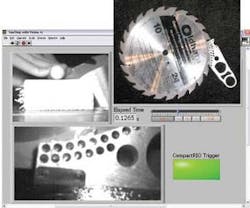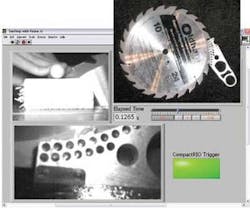Vision and control team to make saws safer
By Andrew Wilson, Editor
Anyone who has operated a table saw has done so with some trepidation. Operators using hand-fed saws are particularly vulnerable since after adjusting the height and angle of the blade, the operator manually pushes the stock into the blade. If the operator’s hands slip while feeding the stock into the saw, or if the operator holds his/her hands too close to the blades, injuries can occur.
At this year’s NIWeek (Austin, TX, USA; Sept. 2005), Shawn Slockers, National Instruments vision hardware engineer, and his colleagues demonstrated a system from SawStop that overcomes the limitations of conventional table-saw designs. By automatically detecting when an operator contacts the spinning saw blade, the intelligent table-saw system automatically stops and retracts the blade in milliseconds, resulting in minimal operator injury.
In the design of the SawStop system, an electrical signal is induced onto the saw blade and the signal monitored. Because the human body has a relatively large inherent electrical capacitance and conductivity, this signal drops when a person contacts the blade. Wood, however, has a relatively small inherent capacitance and conductivity and does not cause the signal to drop.
To induce the signal onto the blade, NI engineers use a number of the company’s off-the-shelf CompactRIO modules to generate and monitor the output of a sinusoidal waveform to and from the saw blade. To generate the required waveform, a single channel of a cRIO-9263, four-channel, 100-kS/s analog output module is used. This signal is monitored using a single channel of a cRIO-9215, four-channel, 100-kS/s analog input module.
By monitoring the amplitude of the analog signal from the saw blade, it is possible to detect when a person comes into contact with the machine. When such an event occurs, the amplitude of the sine wave decreases and the braking system of the saw is triggered. In the system shown at NIWeek, the braking system was triggered using a 5-V/TTL output from a NI 9401-an ultrahigh-speed 100-ns digital input/output module.
When any operator contact is detected, a heavy-duty, fuse-actuated, spring-loaded brake pushes a block of aluminum, called a brake pawl, into the teeth of the blade to stop it from spinning. When contact is detected, the system burns the fuse wire and releases the spring. The spring pushes the brake pawl into the teeth of the spinning blade, and the teeth cut into the aluminum and bind, stopping the blade.
At the show, NI demonstrated a version of the system using a saw blade rotating at 3600 rpm and a hotdog substituted for the human operator’s finger. After contact with the hotdog, the breaking mechanism was triggered, and at the same time the angular momentum of the blade caused the blade to retract below the table and the power to the motor to turn off.
To visualize the operation of the system, NI engineers teamed the Compact RIO control system used in the saw with a high-speed vision system. The NI 9401 that triggered the braking mechanism also triggered the new PCIe-1430 PCI Express frame-grabber board to capture images of the braking process at high speeds. “By using the PCIe-1430 PCI Express frame grabber,” says Slockers, “it is possible to interface with any two high-speed base-configuration Camera Link cameras to simultaneously image both the surface of the table saw and the operation of the brake below.”
The frame grabber was interfaced to both an MV-D1024-160 camera (acquiring at 1200 frames/s) and an MV-D752-160 camera (acquiring at 2700 frames/s) from Photonfocus. While the MV-D1024-160 monitored the table saw, the faster MV-D752-160 imaged the brake mechanism as the 3600-rpm saw blade was halted in less than 5 ms. “Using dual cameras in such a configuration,” says Slockers, “allows designers to easily synchronize the monitoring of separate events or locations in a system.”
Company Info
National Instruments
Austin, TX, USA
www.ni.com
Photonfocus
Lachen, Switzerland
www.photonfocus.com
SawStop
Wilsonville, OR, USA
www.sawstop.com

